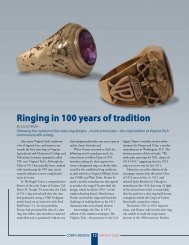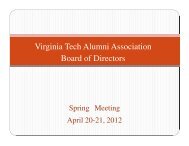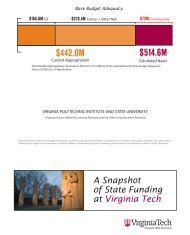during 1944 through 1946, the <strong>Ring</strong> Dance was welcomedback in spring 1947, along with a flood of new war veteransreturning to <strong>Tech</strong> to complete their interrupted education.1958First ring to depict theWar Memorial Pylons.but the numerals continued to be fairly small on the sides ofthe ring in the middle of the shanks.Because of VPI’s expanded enrollment, particularly ofcivilian students, ring dances were split into the Corps Danceand the Civilian Dance—each carrying out its own ring figurefor the ring-exchange ceremony and each with strict guidelinesfor proper attire, ceremony, and decorum. A firmly establisheduniversity tradition, the <strong>Ring</strong> Dance was in its heyday duringthe 1950s and was considered the major social event of junioryear, perhaps of the entire university.1950sConsistent with the burgeoning prosperity across the UnitedStates, VPI experienced considerable growth during the1950s, including an expanding campus and greater number ofcivilian students, most of whom were World War II or KoreanWar veterans finishing their education by way of the G.I. Bill.The VPI campus filled with trailer parks to accommodate themany married students.Reflecting this change in the student population, thedecade’s ring design committees included civilian membersat-large.In addition, rings were designed with a sidededicated to the <strong>Virginia</strong> <strong>Tech</strong> Corps of Cadets (VTCC) anda side dedicated to the Civilian Student Body (CSB), withthe appropriate initials placed on the lower part of the ring’sshanks. Jostens produced the majority of the rings during the1950s, followed by Herff-Jones. The 1951 ring was made byBalfour, and Dieges and Clust made the 1959 ring. Despitethe rings’ different manufacturers, their design and bold lookremained fairly consistent throughout the decade. All ringsof the 1950s are of formidable size, and their designs featurethe traditional eagles, flags, and crossed sabres. Althoughthe depiction of Burruss Hall, Ut Prosim, and 1872 hadbecome fixtures on the VPI ring, the 1958 ring was the firstto depict the War Memorial Pylons, whose construction hadtaken place during the decade. With the Class of 1952, thedepiction of class numbers expanded to the full four digits,1960Daniel Bird, 2014 <strong>Ring</strong>Namesake, served onthe committee to designhis Class of 1960 <strong>Ring</strong>.1960sScience led the way during the “New Frontier” of the 1960s,including the U.S. space race and the threat of nuclear war. In1961, the Highty-Tighties proudly marched in the inaugurationparade of the nation’s vibrant, young president, John F. Kennedy.In less than three years, Kennedy’s assassination would shake thenation. The newly cast Corps cannon was named Skipper in hishonor.In 1962, T. Marshall Hahn Jr., at age 35, became theyoungest university president in <strong>Virginia</strong> <strong>Tech</strong> history. Hahnled major sweeping changes to the campus, academic, andadministrative structures. In 1964, Corps membership wasmade voluntary, and all academic courses were opened towomen.Enrollment almost doubled in the decade, growing from5,747 in 1960 to 11,028 in 1969. The ambitious buildingcampaign on campus included the construction of eight newresidential halls, six new academic buildings, Dietrick Dining<strong>Virginia</strong> <strong>Tech</strong>
Hall, Rector Field House, Cassell Coliseum, and Lane Stadium.Many saw the changes as revolutionary, but this growth wouldeventually help elevate the university to its international statustoday. <strong>Virginia</strong> <strong>Tech</strong> class rings reflected this era of changewith a bold, new look and larger size. With the exception ofthe 1969 ring, the rings of the 1960s have large, divided classnumbers: the numeral 19 on one side and the two-digit classyear on the other side of the shank. The 1966 and 1969 ringsused the class numbers to form the chain around the bezel.Despite these changes, the rings’ traditional elements—theeagle, sabres, university shield, and flags—were prominentlyfeatured.Competition was fierce for the coveted <strong>Tech</strong> ring account.Five companies—Balfour, Herff Jones, Jostens, John Roberts,and Dieges and Clust—all won bids to manufacture the ringsduring the decade. For the Class of 1966, a 23 pennyweight(dwt) ring, the largest available, cost about $60.The tradition of the <strong>Ring</strong> Dance continued to reignsupreme as the event of junior year. The dances featured wellknownorchestras led by Stan Kenton, Larry Elgart, CountBassie, and Duke Ellington. The War Memorial Gym servedas the location until the event was moved to a newly renovatedSquires Student Center in 1969 for the Class of 1970’s dance.A constructed version of the class ring, large enough to walkthrough, became a focal point at the dances during the 1960s.Couples would pass through the center of the ring and thenpause for a photograph and kiss. Dance committees spentmonths on the design and creation of these oversized, detailedrings.Toward the end of the decade, a changing culture createdthe need to spell out the attire and protocol for the dances. TheClass of 1969 <strong>Ring</strong> Dance guide, for example, clearly states thatmini-skirts were not acceptable at either night of the festivities.Although the Vietnam conflict began to escalate in the late1960s, followed closely by the counterculture movement, thedeep traditions established by the <strong>Virginia</strong> <strong>Tech</strong> class ring anddance provided a source of pride and unity for the university’sstudents, both cadet and civilian.1971First ring to depictthe Skipper Cannon.permeated by apathy, cynicism, and waning school spirit. Thelast year of the decade ended on a similarly sour note with theIran hostage crisis.At <strong>Virginia</strong> <strong>Tech</strong>, the Corps of Cadets began acceptingfemale cadets in 1973, three years before the service academies.As civilian enrollment rose at the university, Corps numbersdropped; subsequently, ring design committees during thedecade were comprised predominantly of civilian students.Companies producing rings during the 1970s wereBalfour, Jostens, Herff-Jones, and John Roberts. <strong>Virginia</strong> <strong>Tech</strong>rings continued to get larger, and class years were depicted onboth sides of the ring shanks throughout the decade. The 1971ring was the first to depict the Skipper cannon.Departing from the design of the typical <strong>Virginia</strong> <strong>Tech</strong> ring,the 1977 ring touted a “futuristic housing,” and the designsof the 1978 and 1979 rings featured a more angular, stylizedlook. Elements on the ring, however, remained amazinglytraditional during the decade. Women’s fashion class rings,which had begun to appear in the late 1960s, became morepopular in the 1970s. Signet rings for both men and womenwere also introduced.Since 1934, ring dances had been held in the WarMemorial Gym, except for a few civilian ring dances in themid-1950s that had been held in Squires. Beginning withthe Class of 1970, ring dances moved to the newly renovatedSquires Student Center. Orchestra bands for the formal nightof the dance continued to be a highlight throughout most ofthe 1970s. Some of the popular acts that performed at the ringdances during the decade included Archie Bell and the Drells,Little Anthony and the Imperials, the Chairmen of the Board,the Buckinghams, and Doc Severinsen. Despite its decliningenrollment, the Corps of Cadets played a major role insustaining the traditions of the class ring and the <strong>Ring</strong> Danceduring the 1970s. In fact, some cadets from the decade viewedthe ring as a stabilizing anchor in a turbulent time.1984Uses hemlock needlesto form the chain aroundthe bezel. Hokie stoneis modeled around thepalmside of the ring.1970sThe 1970 Bugle included a section titled “Times They AreA-Changing,” a phrase that accurately describes the ensuingdecade. The first years of the 1970s were still tense withthe Vietnam War, and even <strong>Virginia</strong> <strong>Tech</strong>’s rural campusexperienced student protests, often targeting the Corps ofCadets. By the middle of the decade, after Watergate andtwo separate energy crises, many college campuses were1980sThe rapid enrollment growth of the 1970s slowed in the1980s, but <strong>Virginia</strong> <strong>Tech</strong> continued its transformation into alarger and more diversified university that included a schoolof veterinary medicine. The Blacksburg Transit, or “BT,”established in 1983, expanded the transportation options tocampus as the off-campus student population began to exceedthe campus housing capacity and the number of studentautomobiles overwhelmed the unpaved, gravel parking lots.The Gobbler mascot also seemed to evolve alongside these<strong>Virginia</strong> <strong>Tech</strong>







